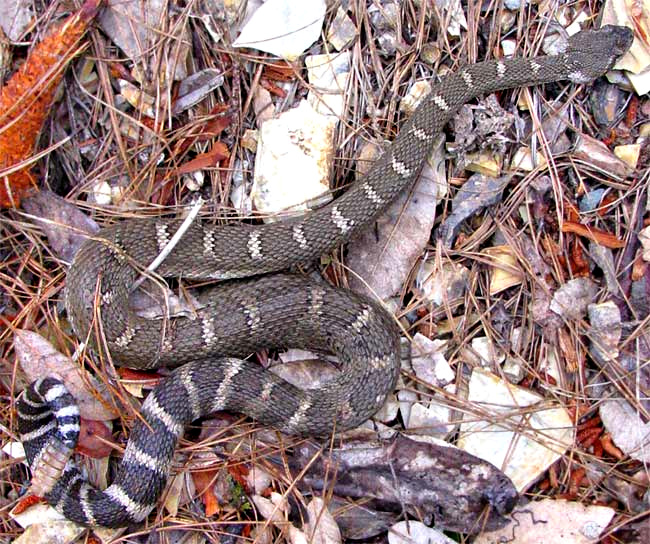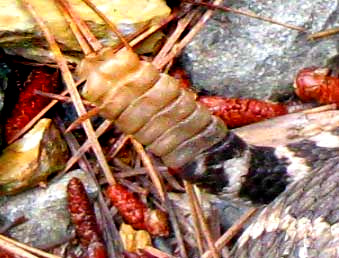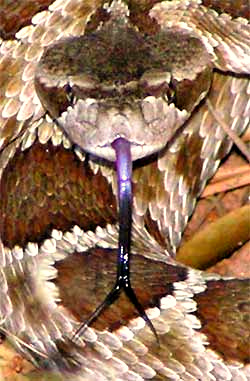Excerpts from Jim Conrad's
Naturalist Newsletter

from the July 19, 2009 Newsletter, issued from the Siskiyou Mountains west of Grants Pass, Oregon:
AN EASY-GOING RATTLESNAKE
Last week's hike into the higher elevations was sort of a washout. The temperature stayed in the low 50s and it was so drizzly and dark that I couldn't photograph, so I just turned around and began hiking back into the valley, head bent low to keep the rain off my glasses. Then I found myself sailing through the air backwards, having almost stepped onto a Western Rattlesnake, CROTALUS OREGANUS. That's him above.
To the snake's credit, he lay beneath a Douglas-Fir out of the drizzle, but otherwise it just didn't seem like the kind of day when a rattlesnake would be out. I guess the cold air accounted for his lethargy, for he was very slow-moving and seemed perfectly willing for me to step on him. He took his time slithering away and even when I picked him up with my walking stick, to get him out of the road, he didn't rattle, didn't strike -- in fact behaved just like somebody's pet boa accustomed to being handled.
The last time I'd run into a Western Rattler, in the Sierra Nevadas back in 2005 (described below) I'd been impressed by how excitable, fast and willing to rattle that individual had been. But that time it'd been very hot, and maybe that made all the difference. Another reason this rattler may have behaved so placidly is that a substantial, rat-size bulge arose at his mid body; he had a good meal inside him.
 At the right you can see a close-up of his rattle. The six bands do not signify that the rattler is six years old. Rattles acquire a new segment each time the snake sheds its skin, which is normally two to four times each year. The six segments, then, would be about normal for a two-year-old rattler, and the rattler's length of a little over two feet also suggests that approximate age.
At the right you can see a close-up of his rattle. The six bands do not signify that the rattler is six years old. Rattles acquire a new segment each time the snake sheds its skin, which is normally two to four times each year. The six segments, then, would be about normal for a two-year-old rattler, and the rattler's length of a little over two feet also suggests that approximate age.
from the September 4, 2005 Newsletter, issued from California's Sierra Nevada Foothills:
A WESTERN RATTLESNAKE

We looked at one another awhile, then he turned tail and fled, holding his tail high and rattling it, sounding very much like the small cicadas we have here, not the larger, very loudly droning cicadas of the East.
What a difference between this excitable, fast-moving Western Rattlesnake, CROTALUS OREGANUS, and the Timber Rattlers, CROTALUS HORRIDUS, I've met so often in the East! I'm used to Timber Rattlers lethargically lying quietly, even when they know they're discovered. Though I've relocated quite a number so people wouldn't hurt them, most of the time they've never even rattled. But this snake was a fast mover and he shook his tail as if his life depended on it.
Another difference between Timber Rattlers and Western Rattlers is that no subspecies of Timber Rattlers are recognized, while Western Rattlesnakes have fractured into eight subspecies in North America. When you consider the West's much more diverse landscape, that's understandable. Among the Western Rattlesnake's subspecies are the Prairie of the great grasslands, the Hopi of desert northeastern Arizona, and the high- elevation Great Basin Western Rattlers.
Here we're located on the boundary between two subspecies, with the Great Basin subspecies mostly higher up and the Northern Pacific subspecies mostly lower down, and my rattler moved so fast I couldn't figure out which subspecies he was.